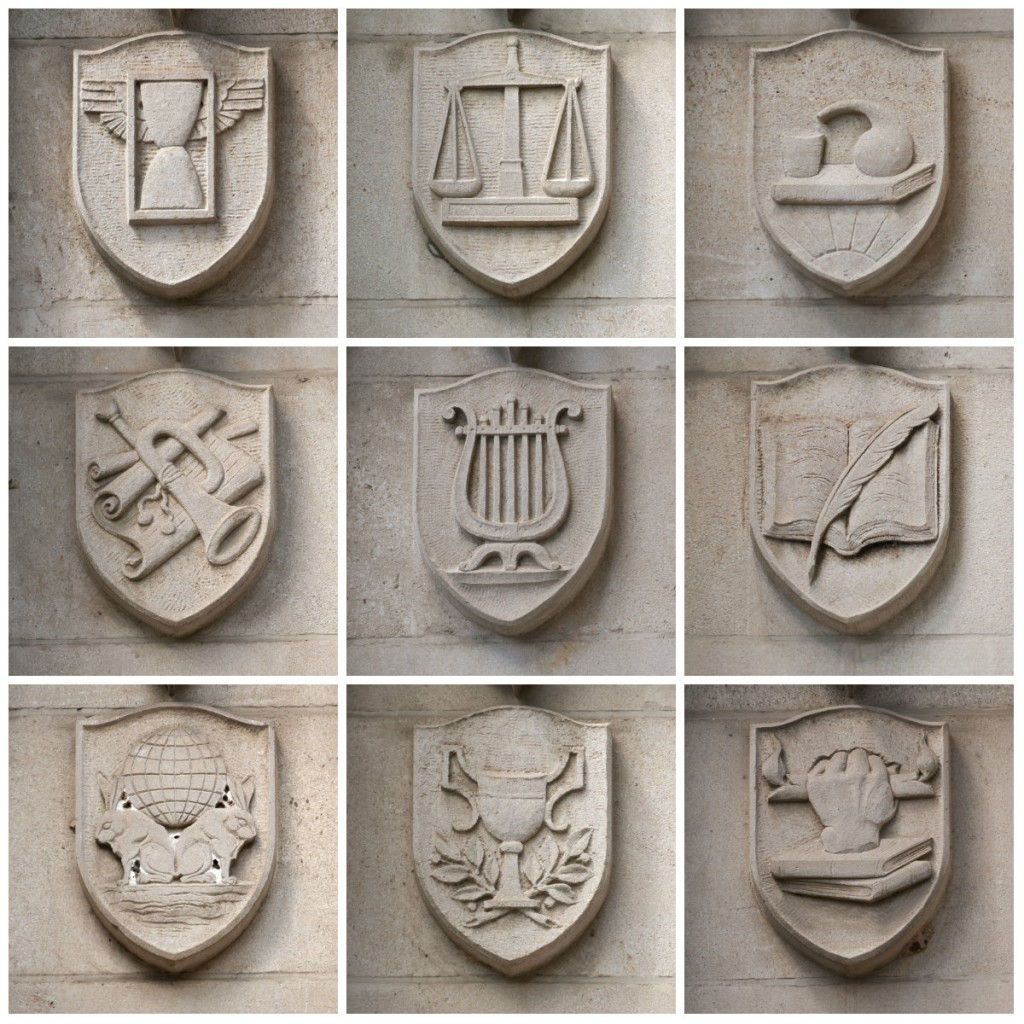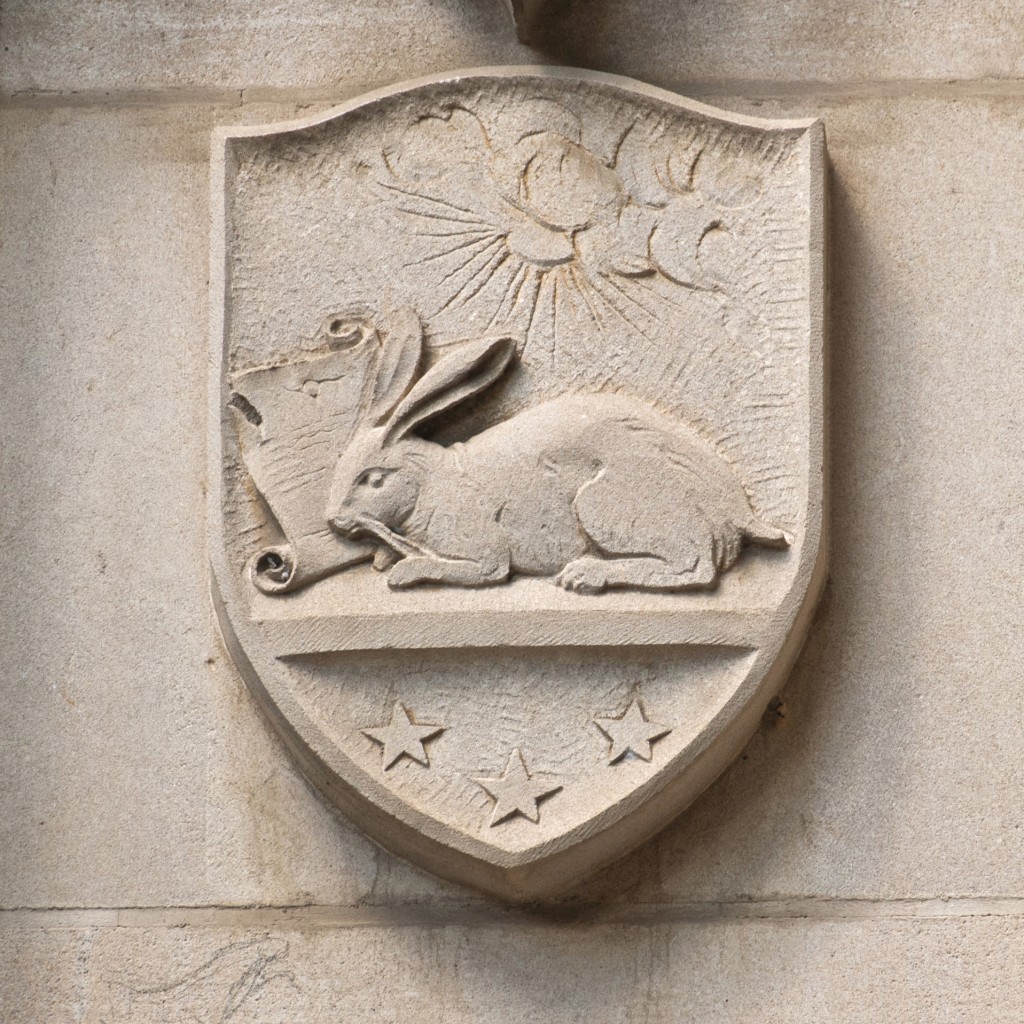By Gwen Hawkes
Bustling among the Gothic archways of Duke’s West Campus, many students never realize that the walls around them are full of hidden symbolism. When the campus was built between 1927 and 1932, a crew of stone carvers employed by John Donnelly, Inc., of New York was commissioned to create the decorative flourishes, stately emblems, and sneering gargoyles that bedeck the university’s buildings and rooftops. Unfortunately, little else is known about the men responsible for these works of art. According to former University Archivist William E. King, it is thought that many of the workers were Irish craftsmen, drawn to America by the promise of work, only to return home upon its completion. (A few stayed in Durham for the rest of their lives.)

The larger mystery surrounding Duke’s stonework is the meaning of the decorations and symbols themselves— particularly those engraved on the recently renamed David M. Rubenstein Rare Book & Manuscript Library. Beneath the windows of the Gothic Reading Room, the front of the library bears twenty-eight stone shields inscribed with various symbols. Because the sculptural designs were left up to the stone carvers themselves, the meaning of these shields has been, for many years, a mystery. The shields were further obscured by several holly trees, effectively blocking them from view, until the trees were removed this summer as part of the library renovation.
University comptroller Frank C. Brown, onetime chair of the English department and founder of the North Carolina Folklore Society, was one of the central figures who oversaw the construction of West Campus. In 1931, Brown contacted the Horace Trumbauer architectural firm in an attempt to discover the significance of the campus carvings. In particular, there was “a demand for an explanation of the various insignia in the Library,” Brown wrote, “because interest in these things increases with the years.” Regrettably, Brown’s letter apparently went unanswered, leaving us to decipher the mystery ourselves.
William Blackburn, legendary professor of English and creative writing at Duke, briefly mentions in his Architecture of Duke University (1946) that the shields on the library represent the various arts and sciences. However after much symbolic detective work, it seems this may be an oversimplification. The shield carvings, which range from the obvious (an open book) to the enigmatic (two rabbits supporting a globe on muscular shoulders) make use of a range of symbolic traditions, from Greek and Roman mythology to Masonic conventions.

Several of the emblems correspond with academic and intellectual endeavors: a lyre to represent poetry, a pair of scales for law or justice, a painter’s palette and brush denoting the visual arts. But most have more subtle meanings. A beehive perhaps represents diligence and industry. A winged hourglass warns against the rapid passage of time and shortness of human life. The lamp of knowledge burns brightly to symbolize enlightenment and education. Despite our best guesses, some of the shields remain stubbornly shrouded in secrecy, to the continuing puzzlement and delight of the viewer. However, each relays some snippet of wisdom to the stream of students racing along beneath them.
Gwen Hawkes (T’16) is an English major and Library Communications Assistant at Duke.
Cracking the Code
Visit our Flickr site to find a full gallery of the library’s stone shields and our best educated guesses about their meanings. A few of the images defied decoding. Their meaning remains tantalizingly elusive. If you can fill in the missing pieces, or correct our interpretations, let us know! Send your brilliant insights, wild conjectures, and learned annotations to Aaron Welborn, editor, at aaron.welborn@duke.edu. We’ll publish the most persuasive contributions as an update in the next issue of the magazine.


Take a journey through some of the emblem books of Andreas Alciati and other emblematists in the emblem collection in rare books. There are many enigmatic symbols there and you may find a clue as to what the artist intended. The emblems were a literary conceit that scholars of the late Renaissance enjoyed combining an image, a “motto,” and a poem.
You may want to explore Arthur Henkel & Albrecht Schöne, Emblemata, Handbuch zur Sinnbildkunst des XVI. und XVII. Jahrhunderts, Verlag J.B. Metzler, Stuttgart – Weimar 1996, ISBN 3-476-01502-5. Massive catalog reproducing emblems with texts from all known 16th and 17th century emblem books.
There is a book in the facilities department that explains the different sheilds all over campus. Each sheild has specific meaning to the precents that the architects used to base the Duke Campus off of.
The Exterior of the Union Building has all the Universities that were looked at to build Dukes Campus.